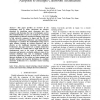Free Online Productivity Tools
i2Speak
i2Symbol
i2OCR
iTex2Img
iWeb2Print
iWeb2Shot
i2Type
iPdf2Split
iPdf2Merge
i2Bopomofo
i2Arabic
i2Style
i2Image
i2PDF
iLatex2Rtf
Sci2ools
JNW
2008
2008
Smart Classrooms for Distance Education and their Adoption to Multiple Classroom Architecture
This paper provides an overview of the technologies used in smart classrooms for distance education by classifying smart classrooms into four categories and discussing the type of technologies used in their implementation. It gives an example of a successful implementation of distance education technology being used to link university campuses in Japan and the US, and describes its underlying architecture and implementation technologies. It examines the methodologies being used to make distance learning an exciting experience and as effective as the traditional classroom type education. Furthermore, the paper shows how a similar architecture can be extended to a model where a single local class can simultaneously cater to the needs of multiple remote classrooms and presents a workable solution to some of the technical challenges that exits in multipoint, multiple classroom architecture. Finally, it shows how some of the inherent challenges of the system are being managed and identifies...
| Added | 13 Dec 2010 |
| Updated | 13 Dec 2010 |
| Type | Journal |
| Year | 2008 |
| Where | JNW |
| Authors | Davar Pishva, G. G. D. Nishantha |
Comments (0)

